Litchi Insect Pests
Litchi Insect Pests
Lithi mite
Biology
- The adults start multiplying from the end of March and the peak activity is noticed around July.
- The female adults lay eggs singly at the base of the hair on the lower surface of the leaves.
- The eggs hatch within 2-3 days and newly emerged nymphs feed on soft leaves.
- Both nymphs and adults damage the leaves, inflorescence and young developing fruits
Damage symptoms:
- The mites puncture and lacerate the tissues of the leaf and suck the cell sap
- They attack the young leaves causing hairy blister like gall on the upper side of the leaves
- The leaves become thickened wrinkled and distorted
- The leaves may ultimately fall off
- The mite also attack and cause malformation of inflorescence
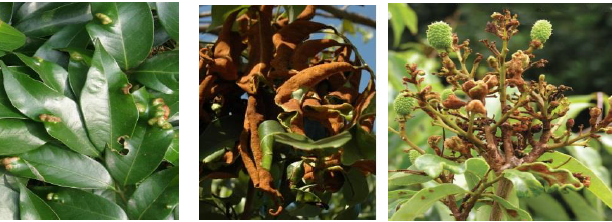
Natural enemies of mite:
Predators: Chrysoperla zastrowii sillemi, anthocorid bug, predatory mite (Amblyseius fallacis), coccinellid (Stethorus punctum) etc.
Litchi fruit borer
Biology
Egg: Female lays eggs singly on the under surface of the leaf or near the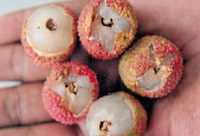 calyx of litchi fruits.
calyx of litchi fruits.
Larvae: milky white, slender with distinct light brown head. The newly emerged larvae start boring into the fruits and feed on its pulp.
Damage Symptoms
The young larvae make mine in the lamina and bore into mid-rib of young leaves and tunnel through it, as a result branches wither and dropNatural enemies of litchi fruit borer
- Parasitoids: Trichogramma chilonis
- Predators: Mirid bug (Campyloneura sp), lady bird beetles (Cheilomenes sexmaculata, Coccinella septempunctata-seven spotted, Brumoides suturalis-three striped), lacewing (Chrysoperla carnea), King crow, common mynah, wasp, dragonfly, spider, robber fly, reduviid bug, praying mantis, fire ants, big eyed bugs (Geocoris sp), pentatomid bug (Eocanthecona furcellata), earwigs, ground beetles, rove beetles etc.
Bark eating caterpillar
Biology
- Egg: Female moths deposit eggs below loose bark, in forks in the older wood, or where twigs have broken off or been badly pruned. Egg hatch 8-10 days after being laid
- Larvae: 50-60 mm and have pale brown bodies with dark brown heads. Caterpillars eat the bark and bore inside the tree, feeding for 9-11 months.
- Adults: Adults are active at the beginning of the wet season in May-June. They are 35-40 mm in size, pale brown or grey in colour
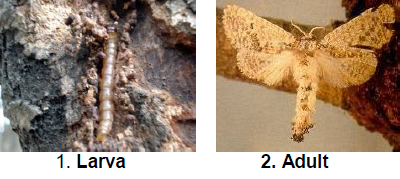
Damage symptoms
- Several caterpillars may attack the same tree at different
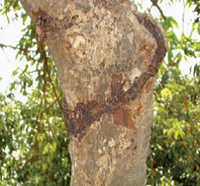 locations with serious injury to the bark and the death of small branches.
locations with serious injury to the bark and the death of small branches. - The holes left on the trunk may lead to infestation by other insects or plant pathogens. Affected trees also break at the points of attack.
- A severe infestation may arrest the growth of the tree and the fruiting capacity
Mealy bug
Biology:
- Egg: Eggs are deposited as white cottony masses called ovisacs. The glossy, light yellow eggs are oval and approximately 0.3 mm long. A female lay 300 to 600 eggs in a life period, which are deposited in groups of 5 to 20.
- Nymph: Nymphs emerge from the ovisacs and typically settle along midribs and veins on the underside of leaves and young twigs. Wax and honeydew secreted by crawlers are visible indicators of infestations. The nymphs are yellow, oval-shaped with red eyes, and covered with white waxy particles The female nymphs resemble the adult female in appearance, while male nymphs are more elongated. Female nymphs have four instars.
- Adult: Adult size ranges in length from 3 mm (females) to 4.5 mm (males). The females are wingless, white to light brown in color, with brown legs and antennae. The body of adult females is coated with white wax and bears a characteristic faint gray stripe along their dorsal side. Short waxy filaments can be seen around the margins of their oval body with a slightly longer pair of filaments present at the rear end of their body.
Life Cycle:
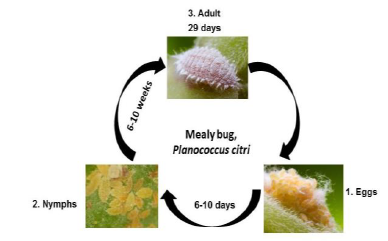
Damage symptoms:
- Young plants – susceptible for heavy infestation.
- Infest tender branches, nodes, leaves, spikes, berries and roots
- Both nymphs and adults suck the sap from the leaves.
- Severe infestation - Chlorotic leaves, aborted flower buds and small berries
- Honey dew excrete – development of sooty mould fungus (affects photosynthesis)
Natural enemies of mealybugs:
- Parasitoid: Leptomastix dactylopii etc.
- Predators: Ladybird beetle, Cryptolaemus montrouzieri, spider, reduviid etc.
Whitefly
Biology:
- Egg: The females mostly lay eggs near the veins on the underside of leaves. They prefer hairy leaf surfaces to lay more eggs. Each female can lay about 300 eggs in its lifetime. Eggs are small (about 0.25 mm), pear-shaped, and vertically attached to the leaf surface through a pedicel. Newly laid eggs are white and later turn brown. The eggs are not visible to the naked eye, and must be observed under a magnifying lens or microscope. Egg period is about three to five days during summer and 5 to 33 days in winter.
- Nymph: Upon hatching, the first instar larva (nymph) moves on the leaf surface to locate a suitable feeding site. Hence, it is commonly known as a “crawler.” It then inserts its piercing and sucking mouthpart and begins sucking the plant sap from the phloem. The first instar nymph has antennae, eyes, and three pairs of well developed legs. The nymphs are flattened, oval-shaped, and greenishyellow in color. The legs and antennae are atrophied during the next three instars and they are immobile during the remaining nymphal stages. The last nymphal stage has red eyes. This stage is sometimes referred to puparium, although insects of this order (Hemiptera) do not have a perfect pupal stage (incomplete metamorphosis). Nymphal period is about 9 to 14 days during summer and 17 to 73 days in winter (David 2001). Adults emerge from puparia through a T-shaped slit, leaving behind empty pupal cases or exuviae.
- Adult: The whitefly adult is a soft-bodied, moth-like fly. The wings are covered with powdery wax and the body is light yellow in color. The wings are held over the body like a tent. The adult males are slightly smaller in size than the females. Adults live from one to three weeks.
Life cycle:
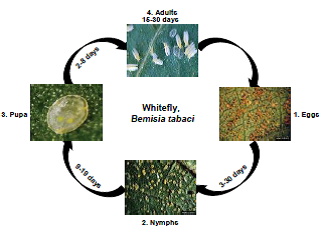
Damage symptoms:
Both the adults and nymphs suck the plant sap and reduce the vigor of the plant. In severe infestations, the leaves turn yellow and drop off. When the populations are high they secrete large quantities of honeydew, which favors the growth of sooty mould on leaf surfaces and reduces the photosynthetic efficiency of the plants.
Natural enemies of whitefly:
- Parasitoids: Encarsia sp, Eretmocerus sp, Chrysocharis pentheus
- Predators: Mirid bug (Dicyphus hesperus), dragonfly, hover fly, spider, robber fly, praying mantis, fire ants, coccinellids, lace wings, big eyed bugs (Geocoris sp) etc.
IPM for Litchi
To know the IPM practices for Litchi, click here.
Source: NIPHM, Directorate of Plant Protection, Quarantine & Storage
Last Modified : 3/30/2020
This topic provides information about Coriander I...
This topic covers information about Pomegranate I...
This topic covers information about Broccoli Ins...
This topic covers the information related to Insec...
